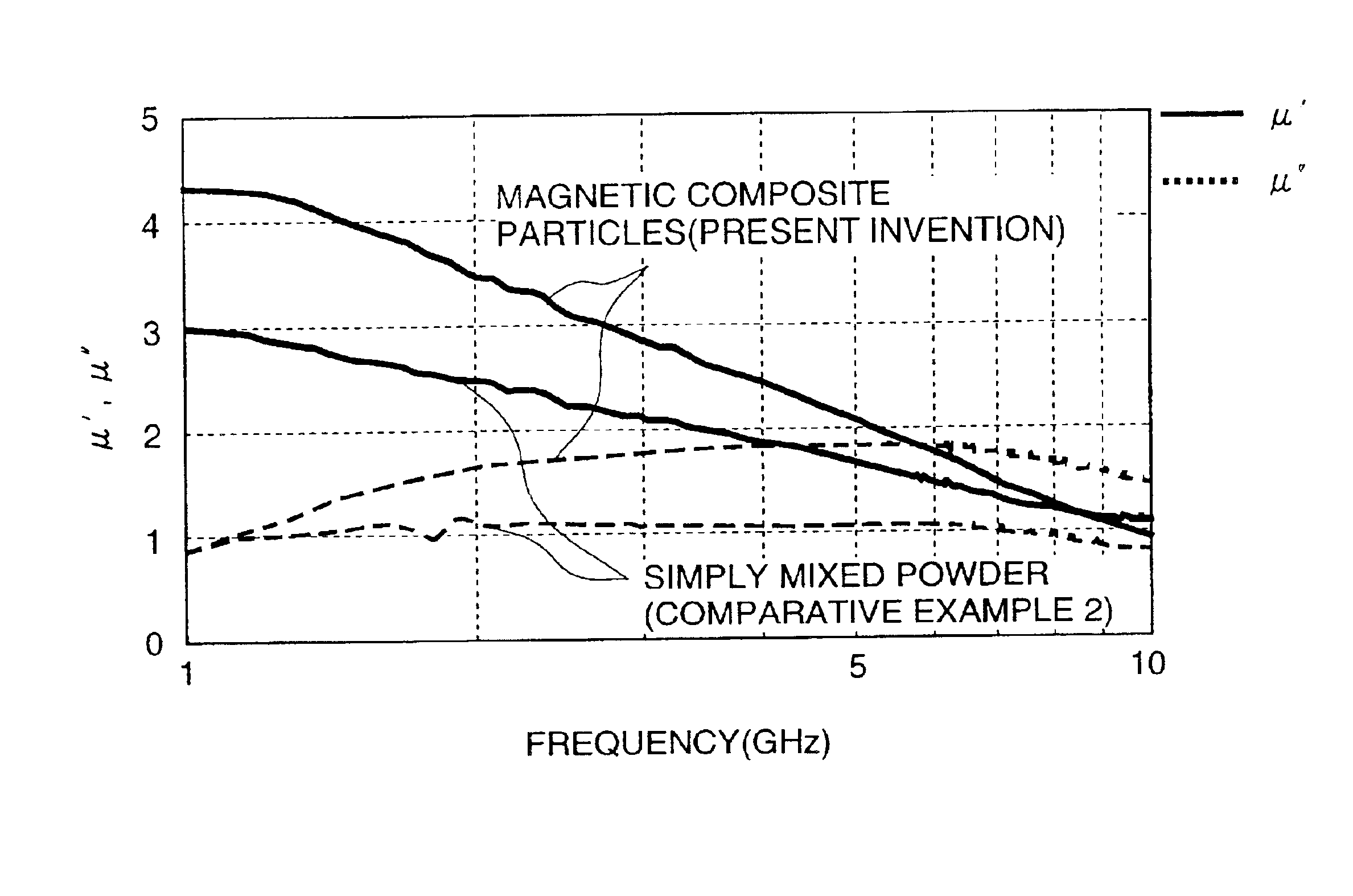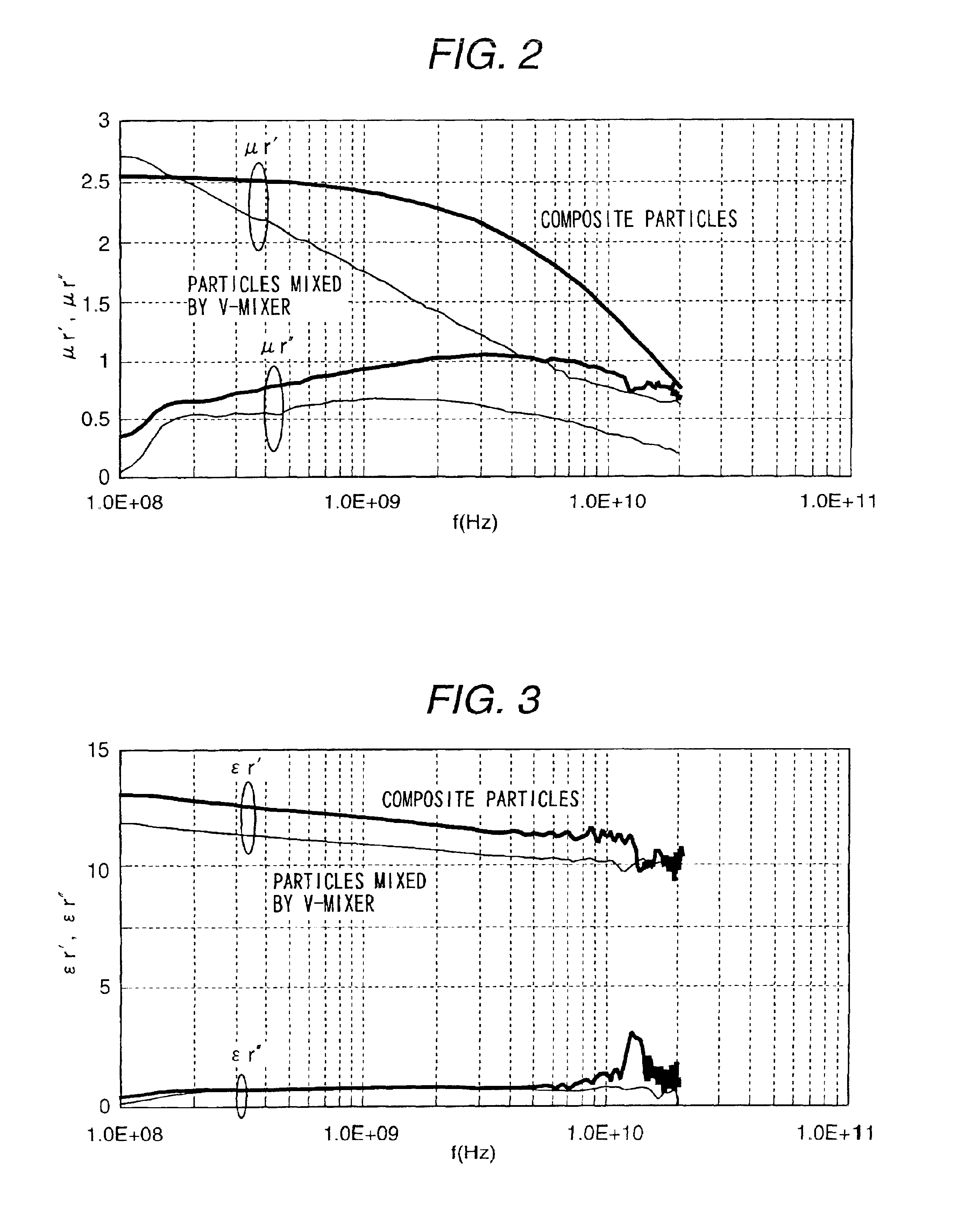Electromagnetic wave absorber, method of manufacturing the same and appliance using the same
a technology of electromagnetic waves and absorbers, which is applied in the direction of instruments, nuclear elements, and semiconductor/solid-state device details, etc., can solve the problems of erroneous equipment operation, unfavorable noise emission, and deterioration of the noise environment inside the equipment, so as to achieve excellent suppress noise interference inside the module. , good electromagnetic wave absorption characteristics
- Summary
- Abstract
- Description
- Claims
- Application Information
AI Technical Summary
Benefits of technology
Problems solved by technology
Method used
Image
Examples
embodiment 1
(Embodiment 1)
[0080]A mixed powder consisting of Fe powder of 50 vol % having grain size of 1 to 5 μm and SiO2 powder of 50 vol % having an average grain size of 0.3 μm, and balls made of SUS410 (diameter: 9.5 mm) with a weight ratio of the powders to the balls=1 to 80 were put into a pot made of stainless steel, and the pot was filled with argon gas, and MA (mechanical alloying) treatment was performed thereon at a rotation speed of 200 rpm for 100 hours. The composite magnetic particles after the MA was of indefinite shape, having complicated shapes, and the average particle size was several tens μm.
[0081]FIG. 1 is a photograph of the structure obtained from observation of the composite magnetic particle using a TEM. The crystal grain size of Fe of the black portion in the photograph is 10 nm, and the composite magnetic particle has a complicated shape, and Si oxide of the white portion is formed in a network-shape so as to enclose Fe grains having a grain size below 100 nm. The f...
embodiment 2
(Embodiment 2)
[0090]A mixed powder consisting of Fe powder having a grain size of 1 to 5 μm and soft magnetic metal oxide powder of (Ni—Zn—Cu)Fe2O4 or (Mn—Zn)Fe2O4 (50:50 in volume ratio) having an average grain size of 0.7 μm, and balls made of SUS410 (diameter: 9.5 mm) with a weight ratio of the powders to the balls=1 to 80 were put into a pot made of stainless steel, and the pot was filled with argon gas, and MA (mechanical alloying) treatment was performed at a rotation speed of 200 rpm for 100 hours. The composite magnetic particles after the MA was of indefinite shape, and the average particle size was several tens μm. Further, the result of observing the composite magnetic particle using a TEM was similar to that of Embodiment 1. The crystal grain size of Fe was about 10 nm, and oxides including components of the soft magnetic metal oxide were finely dispersed in a network shape in the crystal grain boundary. Annealing of the composite magnetic particles was performed in a va...
embodiment 3
(Embodiment 3)
[0092]A powder obtained by mixing Fe powder having a grain size of 1 to 5 μm and Si powder having an average grain size of 1.0 μm of 50:50 in volume ratio, and the same balls made of SUS410 as described above with a weight ratio of the powders to the balls=1 to 80 were put into a pot made of stainless steel together, and the pot was filled with oxygen gas (Ar:O2=4:1), and mechanical alloying (MA) treatment was performed at a rotation speed of 200 rpm for 100 hours. The composite powder after the MA was of indefinite shape, and the average particle size was 5.0 μm. Further, as a result of observing the composite magnetic particle using a TEM, the crystal grain size of Fe was about 10 nm, and oxides including components of Si oxide were finely dispersed in a network shape in the crystal grain boundary. Further, as a result of an X-ray diffraction analysis, it was checked that there were Fe oxides (Fe2O3, Fe3O4). Similarly to the method described above, various kinds of c...
PUM
| Property | Measurement | Unit |
|---|---|---|
| grain size | aaaaa | aaaaa |
| crystal grain size | aaaaa | aaaaa |
| aspect ratio | aaaaa | aaaaa |
Abstract
Description
Claims
Application Information
 Login to View More
Login to View More - R&D
- Intellectual Property
- Life Sciences
- Materials
- Tech Scout
- Unparalleled Data Quality
- Higher Quality Content
- 60% Fewer Hallucinations
Browse by: Latest US Patents, China's latest patents, Technical Efficacy Thesaurus, Application Domain, Technology Topic, Popular Technical Reports.
© 2025 PatSnap. All rights reserved.Legal|Privacy policy|Modern Slavery Act Transparency Statement|Sitemap|About US| Contact US: help@patsnap.com



